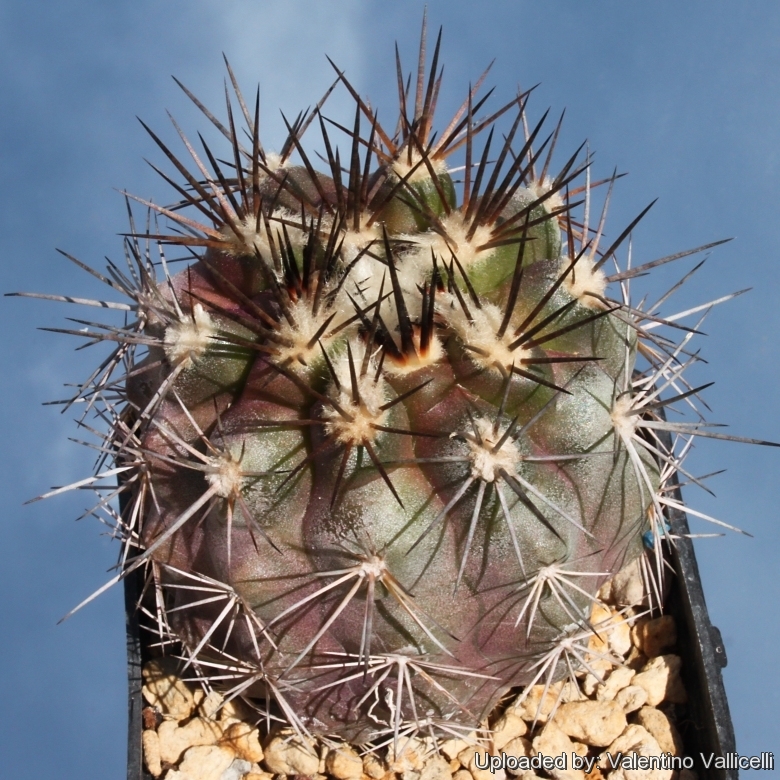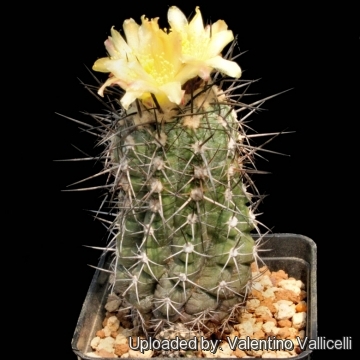
Copiapoa calderana subs. atacamensis Photo by: Valentino Vallicelli
WM 387
Origin and Habitat: Distribution: between Paposo and Cerro Moreno, Atacama Desert in the province of Antofagasta, Northern Chile.
Altitude: 100-1100 metres above sea level.
Habitat: It grows in the Atacama Desert, one of the driest places in the world. It is found in barren rocky land, but with protection from direct sun through coastal fog (camanchaca) and obtain water mainly from condensation of the fog, they only manage to survive in those conditions.
Synonyms:
See all synonyms of Copiapoa calderana
back
Accepted name in llifle Database:Copiapoa calderana subs. atacamensis (Middled.) DoweldSukkulenty et also: D.R.Hunt [or Mottram?] in: Cactaceae Syst. Init. 13: 12. 2002 [Apr 2002]Synonymy: 2
Accepted name in llifle Database:Copiapoa calderana F.RitterCactus (Paris) xiv. No. 65, 197 (1959)Synonymy: 9
back
Common Names include:
SPANISH (Español): Atacameño
Description: Copiapoa atacamensisSN|1739]]SN|1741]] is a spherical very spiny cactus which is often listed as a synonym of Copiapoa calderanaSN|1739]]SN|1739]], but it occurs disjunctly with minor frequence and its relationship with Copiapoa calderanaSN|1739]]SN|1739]] is unclear. It is probably a good species (or at the most a subspecies) rather than a variety of Copiapoa calderanaSN|1741]]SN|1739]].
Habit: Either solitary or forming massive clumps consisting of many stems.
Root: It has a big taproot which is considerably longer than the stem and serves for storing water. The main root may be several times the length of the above-ground body.
Stem: Globose, to elongate globose up to 12 cm across, grey-green with a greyish bloom and crowned by a dense mass of silky dull-yellow or brownish wool, particularly at flowering time. The grey colouration is a waxy coating presumably produced to prevent desiccation in it's extremely dry environment. In cultivation the waxy bloom is often not produced, revealing a green epidermis.
Ribs: 12–13(-16) sharp, to obtuse, slightly rounded and barely dissolved in tubercles. Usually straight but occasionally spirally arranged.
Areoles: 3-10 mm in diameter, almost round, approximate, the adjoining ones usually touching. Young areoles filled with soft yellowish to orange-brownish felted wool, turning grey or blackish, later almost glabrous.
Spines: Very variable in colouration, black, brown or grey.
Central spine: Single, straight, pointing outward, tapering, nearly bristle-like 33–38 mm long.
Radial spines: 5-7 more slender, slightly backward curved, 10–12 mm long.
Flowers: Few at a time, opening widely, diurnal closing at night, fragrant, protracting the period of opening many days, funnel-shaped, 3–3,5 cm long.
Fruit: Green to pink coloured, with a few scales.
Bibliography: Major references and further lectures
1) Edward Anderson “The Cactus family” Timber Press, Incorporated, 2001
2) James Cullen, Sabina G. Knees, H. Suzanne Cubey "The European Garden Flora Flowering Plants: A Manual for the Identification of Plants Cultivated in Europe, Both Out-of-Doors and Under Glass" Cambridge University Press, 11/Aug/2011
3) David R Hunt; Nigel P Taylor; Graham Charles; International Cactaceae Systematics Group. "The New Cactus Lexicon" dh books, 2006
4) N. L. Britton, J. N. Rose “The Cactaceae. Descriptions and Illustrations of Plants of the Cactus Family.” Volume 4, The Carnegie Institution of Washington, Washington 1923
5) Urs Eggli, Leonard E. Newton “Etymological Dictionary of Succulent Plant Names” Birkhäuser 2004, ISBN 3-540-00489-0, page. 17.
3) H. Middleditch “Copiapoa atacamensis H. Middleditch spec. nov.” In: Chileans, The Hetton le Hole, Bristol, Guildford, etc. Volume 11, Number 37, 1979, page. 20–21.
 - Locality: Near Morro Moreno, Antofagasta, Chile Photo by: Valentino Vallicelli
- Locality: Near Morro Moreno, Antofagasta, Chile Photo by: Valentino Vallicelli Morro Moreno, Antofagasta Region II, Chile Photo by: Valentino Vallicelli
Morro Moreno, Antofagasta Region II, Chile Photo by: Valentino VallicelliCultivation and Propagation: This cactus is kept for the beauty of its form. It is a summer grower species slow but easy to cultivate that like many cacti of the Peruvian deserts, present some problems in cultivation. It is in fact somewhat rot prone if kept in a non ventilated place.
Growth rate: It is a relatively rapidly growing and easily flowering species that will make clumps given the best conditions.
Soils: It likes very porous standard cactus mix soil, but can become too elongated if compost is too rich.
Repotting: Use pot with good drainage.
Watering: Water regularly from Spring to Autumn, but do not overwater and let the soil mix dry between waterings (Rot prone), keep dry in winter.
Fertilization: Feed with a high potassium fertilizer in summer.
Hardiness:Keep warm and dry in winter (10°C) to avoid rot. Not highly tolerant of a great deal of frost. (Frost tolerance 0°C)
Exposition: Requires full sun or light shade and careful watering to keep plant compact with strong coloured spines. Tends to bronze in strong light, which encourages flowering and heavy spine production. It must be protected from excessive heat and sun in summer.
Uses: It is an excellent plant for container growing. It always looks good and stays small. It look fine in a cold greenhouse and frame or outdoor in a rockery.
Pests & diseases: It may be attractive to a variety of insects, but plants in good condition should be nearly pest-free, particularly if they are grown in a mineral potting-mix, with good exposure and ventilation. Nonetheless, there are several pests to watch for:
- Red spiders: Red spiders may be effectively rubbed up by watering the infested plants from above.
- Mealy bugs: Mealy bugs occasionally develop aerial into the new growth among the wool with disfiguring results, but the worst types develop underground on the roots and are invisible except by their effects.
- Scales: Scales are rarely a problem.
It is wise to treat your whole collection with a systemic insecticide twice a year in spring and autumn.
- Rot: Rot is only a minor problem with cacti if the plants are watered and “aired” correctly. If they are not, fungicides won't help all that much.
Propagation: Seeds (or offsets if available) or by grafting onto a strong grafting stock like Selenicereus sp. Such grafted seedlings can be successfully cultivated for years. Grafting is often used to speed growth rate and to create a back-up to plants in collection. Seeds germinate in 7-14 days at 21-27° C in spring, remove gradually the glass cover as soon the plants will be well rooted (ca 1-2 weeks) and keep ventilated, no full sun for young plants!













